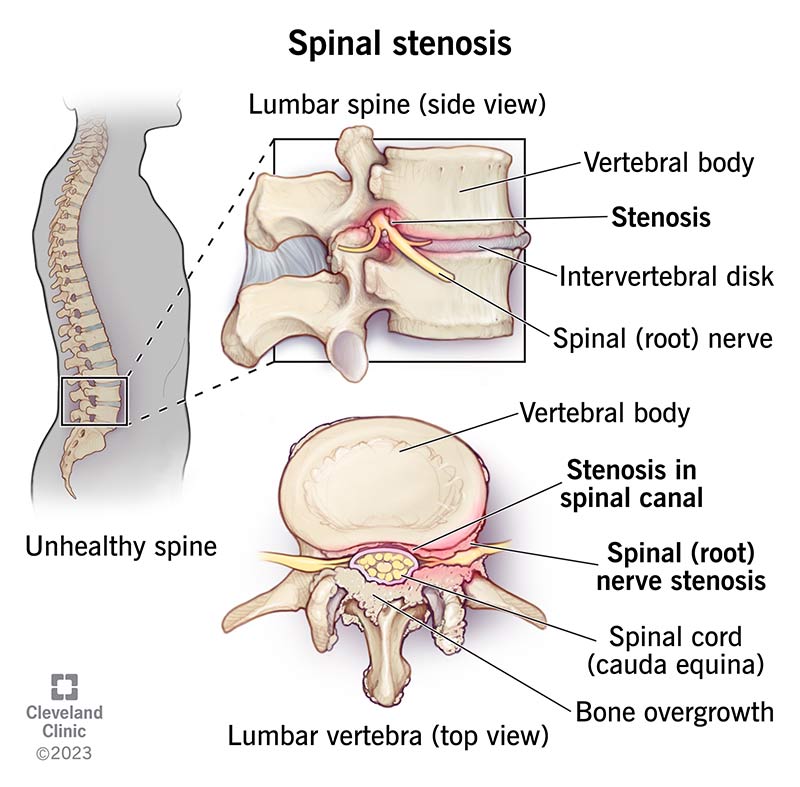Spinal stenosis happens when the space around your spinal cord becomes too narrow. This irritates your spinal cord and/or the nerves that branch off it. Spinal stenosis causes symptoms like back or neck pain and tingling in your arms or legs. There are several causes, as well as several treatment options.
Advertisement
Cleveland Clinic is a non-profit academic medical center. Advertising on our site helps support our mission. We do not endorse non-Cleveland Clinic products or services. Policy

Spinal stenosis is the narrowing of one or more spaces within your spinal canal. Your spinal canal is the tunnel that runs through each of the vertebrae in your spine. It contains your spinal cord. Less space within your spinal canal cramps your spinal cord and the nerves that branch off it (nerve roots).
Advertisement
Cleveland Clinic is a non-profit academic medical center. Advertising on our site helps support our mission. We do not endorse non-Cleveland Clinic products or services. Policy
A tightened space can cause your spinal cord or nerves to become irritated, compressed or pinched. This can lead to back pain and other nerve issues, like sciatica. Several conditions and injuries can lead to a narrowed spinal canal.
Spinal stenosis can affect anyone, but it’s most common in people over the age of 50.
The condition most commonly affects two areas of your spine:
Your middle back (thoracic spine) can also have spinal stenosis, but this is rare.
Spinal stenosis is fairly common. Degenerative spinal changes affect up to 95% of people by the age of 50. Spinal stenosis is one of those changes. For people over 65 undergoing spine surgery, lumbar spinal stenosis is the most common diagnosis.
Depending on where and how severe your spinal stenosis is, you might feel the following in your neck, back, arms, legs, hands or feet:
Advertisement
Spinal stenosis usually develops slowly over time. For this reason, you may not have any symptoms for a while, even if it shows up on X-rays or other imaging tests. Symptoms may come and go and affect each person differently.
Symptoms of lumbar (low back) spinal stenosis include:
You can feel symptoms of cervical spinal stenosis anywhere below the point of the nerve compression in your neck. Symptoms include:
Pain from spinal stenosis can feel different from person to person. Some describe it as a dull ache or tenderness. Others describe it as an electric-like or burning sensation. The pain can come and go.
Spinal stenosis has several causes. Many different changes or injuries in your spine can cause a narrowing of your spinal canal. The causes are split into two main groups:
Acquired spinal stenosis is more common. It usually happens from “wear and tear” changes that naturally occur in your spine as you age. Only 9% of cases result from congenital causes.
Acquired spinal stenosis means you develop it later in life (after birth) — most commonly after the age of 50. These cases usually happen from an injury or changes in your spine that occur as you age (degenerative changes).
Causes of acquired spinal stenosis include:
Advertisement
Congenital spinal stenosis affects babies and children. It can happen due to:
Some congenital causes of spinal stenosis include:
Advertisement
Your healthcare provider will review your medical history, ask about your symptoms and do a physical exam. Your provider may feel your spine, pressing on different areas to see if it causes pain. They’ll likely ask you to bend in different directions to see if certain spine positions bring on symptoms.
You’ll also have imaging tests so your provider can “see” your spine and determine the exact location, type and extent of the problem. These tests may include:
There are many treatment options for spinal stenosis. What’s best for you depends on:
Advertisement
If your symptoms are mild, your healthcare provider may recommend at-home care first. If these methods don’t work and as symptoms worsen, your provider may recommend physical therapy, medications, injections and, finally, surgery.
At-home care may include:
Nonsurgical treatments mainly help manage symptoms of spinal stenosis. They include:
Spinal stenosis is complex, and your spine is a delicate area. Because of this, providers consider surgery only if all other treatment options haven’t worked. Fortunately, most people who have spinal stenosis don’t need surgery.
Types of spine surgery include:
The prognosis (outlook) for spinal stenosis varies based on several factors, like:
In most cases, the prognosis for spinal stenosis is good. Many people with spinal stenosis can live full and active lives with nonsurgical treatment. But it’s important to remember that spinal stenosis affects each person differently, so not every treatment works for everyone.
In severe cases, spinal stenosis can cause a loss of bladder or bowel control (incontinence). It can also cause sexual dysfunction due to nerve issues, like erectile dysfunction or anorgasmia.
It’s very rare, but extreme cases of spinal stenosis can cause partial or complete leg paralysis.
As most causes of spinal stenosis are normal age-related “wear and tear” conditions, you can’t totally prevent spinal stenosis. But you can take certain steps to keep your spine healthy. They may help lower your risk or slow the progression of spinal stenosis. These steps include:
If you notice new back pain or other symptoms, like tingling or weakness in your extremities, talk to a healthcare provider.
If you’re receiving treatment for spinal stenosis and it’s not working to help your symptoms, talk to your provider about other options.
Back and neck pain can interrupt your daily life. The good news is that there are many treatment options for spinal stenosis. See your healthcare provider to discuss your options. They’re available to help.
Back pain. Neck pain. Tingling. Numbness. All can be signs of spinal stenosis. Cleveland Clinic has the treatments you need to get back to enjoying life.

Last reviewed on 06/30/2023.
Learn more about the Health Library and our editorial process.